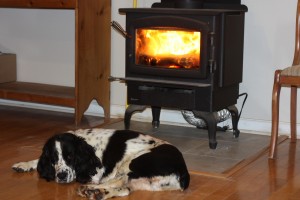It’s 31 degrees outside. Nothing special if you’re living in Ontario, but here in Central Alabama that’s a cold morning. Here in our little home, though, it’s 75 degrees.

That silver pipe below the stove is the outside air intake. The electrical cord powers a fan we’ve never used.
It’s warmest right by the stove, of course, which is why Oddie prefers a front-row seat on cold mornings. But that’s not why I’m writing this. I’m writing this because of what it feels like throughout the room. Our wood stove has a remarkable ability to heat our entire home without using any fans or “air movers.” It warms so well by the simple use of convection, the tendency of warm air to rise and cool air to fall.
The fire in the stove (which uses remarkably little wood, by the way) means there’s a very hot box sitting in our home surrounded by air. Not just in front of it, but also beside it, below it, above it, and behind it. The air touching that box heats up quickly and rises. When it reaches the ceiling, it fans out and pushes down the cooler air in the room. This air movement creates turbulence, but the cool air eventually reaches the floor.
Meanwhile, back at the stove, that air that heated and rose has left a vacuum, a hole that needs to be filled. The cool air near the base of the stove rushes in to fill the vacuum, pulling the cool air from throughout the floor along behind it. The result is a steady flow of air throughout our little home that – within an hour or so – has our whole home feeling toasty and cozy. The wood stove is constantly reaching out, finding the coolest air in our home, and heating it.
Now here’s the remarkable part, the reason the wood stove – in Amanda’s words – “warms your cockels.” I’ve just described a constant, rather complex pattern of air movement and turbulence that you might think would leave you feeling like you’re sitting near a wind machine. It doesn’t. All that movement and turbulence I’ve described circulates the air remarkably effectively, but so slowly, so subtly, that no person I know of could ever detect it. All we humans feel is warmth, deep, comforting warmth that relaxes you down to your soul.
When we were shopping for our Regency F1100 stove, we first looked for a stove encased by soapstone because we heard it would retain heat better. That may be, but we have been pleasantly surprised by how long our stove continues to warm after we start a fire. Long after the fire seems to be out, there are hot embers continuing to give off heat even though encased in a layer of ash. The updated design of our stove causes complete combustion. If a fire burns out naturally, nothing but ash remains in the firebox; no little chunks of unburned wood like those we always found in the fireplace of our suburban home. And the stove’s cast iron firebox stays warm for hours after the fire goes out.
I love our woodstove, too. We had a galvanized fireplace years ago, and replaced it with a Jotul model 118 Norwegian box stove that has a “smoke chamber” on top, that further extracts heat from the gases, before going out the chimney. The wood stove store here in North Central Florida told us back then that a fireplace is (plus)10% to(minus)10% efficient, compared to an airtight wood stove. This means one has to haul a WHOLE lot less wood in to burn, to get the same amount of heat from it. – we got the wood stove, and it heats the whole 2000 sq. ft. home fine. Nothing beats wood heat! Sure beat the air to air heat pump we have!
Ps, do ya’ll have a facebook page? Thanks! Steve.